What Is the 1956 Lincoln Wheat Penny Made Of?
The Lincoln penny or Lincoln cent in 1956 bears a value of one cent. It is made of 95% copper and 5% zinc, and tin. The penny also has the same composition starting from 1909 to 1942. In 1943, it was made of zinc-plated steel. Then, from 1944 to 1982, the original composition was retained. It was then changed once again in 1982 up to the present, making it 97.5% zinc and 2.5% copper.
The 1956 penny is 2.5 grams, making it one of the lightest coins produced by the US Mint. Aside from that, the 1956 Lincoln penny has a diameter of 19.05 mm and a plain edge.
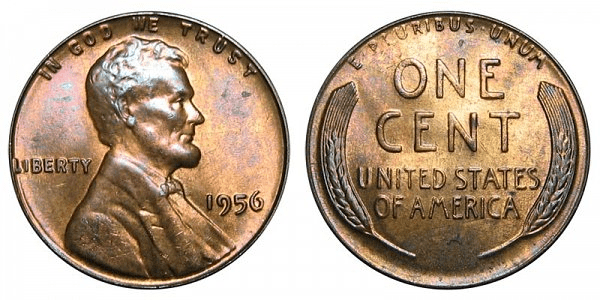
The design of the Lincoln penny remained the same throughout the years. Victor David Brenner made the original design. He designed both the reverse and obverse of the coin. However, in 1959, the reverse wheat design of Brenner was changed to depict the Lincoln Memorial. Today, the penny’s reverse depicts a Union shield designed by Lyndall Bass.
For the 1956 Lincoln wheat penny, you’ll see on its obverse the left profile of Abraham Lincoln, the sixteenth president of the United States. Inscriptions include the following:
- IN GOD WE TRUST
- LIBERTY
- 1956
On the reverse, you’ll find the two stalks of wheat on the left and right area of the coin. This is why the pennies produced from 1909 to 1958 were called wheat pennies. Inscriptions include the following:
- E PLURIBUS UNUM
- ONE CENT
- UNITED STATES OF AMERICA
1956 Lincoln Wheat Penny Varieties
The 1956 Lincoln penny varieties include three original designs. These are the 1956 P, 1956 D, and 1956 proof pennies. The US Mint issued a total of 1,519,615,484 1956 pennies. Aside from the standard struck pennies, some error coins sporadically appear due to minting errors.
Here are the 1956 Lincoln penny varieties you should know:
1956 D Lincoln Penny
Year of minting: 1956
Mint Mark: D
Place of minting: Denver
Quantity produced: MINTAGE: 1,098,201,100
Face Value: $0.01 (one cent)
Price: $0.01 to $7.00 (or more)
Mass: 3.11 grams
Edge: Plain
Designer: Victor D. Brenner (obverse)
Composition: 95% copper and 5% zinc and tin
Diameter: 19.05 mm
Thickness: 1.52 mm
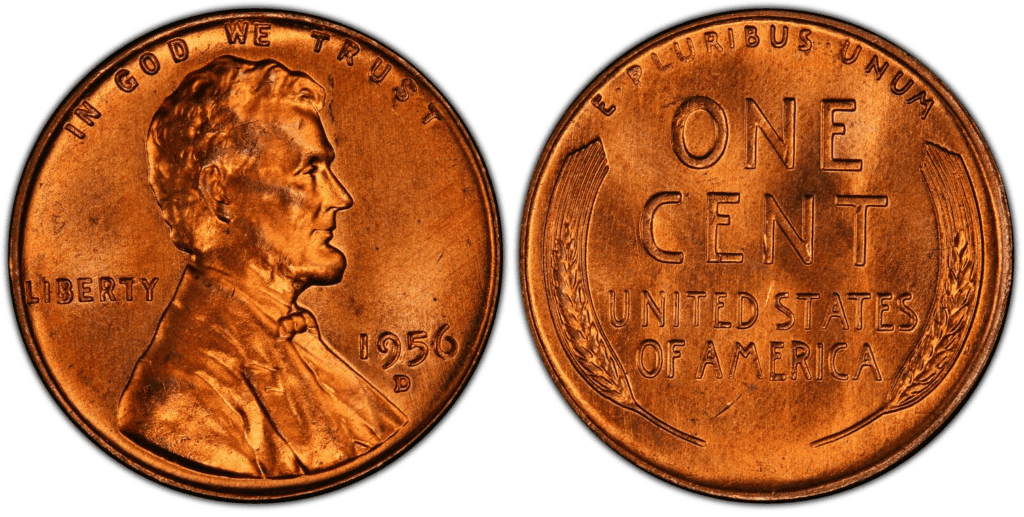
The Denver Mint produced more than 1.05 billion 1956 D pennies, the highest mintage for this penny series. This was the first time the Denver Mint exceeded a billion production pieces. The reason was that the San Francisco Mint was closed, and the Denver Mint needed to work harder to compensate for the lost coin production.
The price range of the 1956 D penny is $0.01 to $7.00. The 1956 D pennies are common in grades up to MS 66.
1956 P Lincoln Penny
Year of minting: 1956
Mint Mark: None
Place of minting: Philadelphia
Quantity produced: 420,745,000
Face Value: $0.01 (one cent)
Price: $0.01 to $7.00 (or more)
Mass: 3.11 grams
Edge: Plain
Designer: Victor D. Brenner (obverse)
Composition: 95% copper and 5% zinc and tin
Diameter: 19.05 mm
Thickness: 1.52 mm
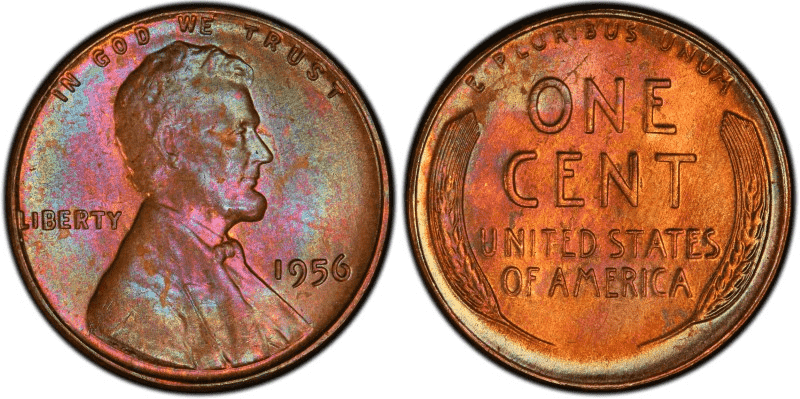
The Philadelphia Mint produced more than 420 million Lincoln pennies in 1956. Its price can be between $0.01 to $7. Like most of the coins produced by the Philadelphia Mint, the 1956-P penny doesn’t have a mint mark.
There was a massive increase in the production of the Lincoln pennies in 1956 compared to the previous year. This means that the 1956 Lincoln penny should be easy to find, even in red gem condition. Coins of this type in grades up to MS 66 are pretty standard. Only at the MS 67 grade does the coin start to be scarce.
1956 Lincoln Penny (Proof)
Year of minting: 1956
Mint Mark: None
Place of minting: Philadelphia
Quantity produced: 669,384
Face Value: $0.01 (one cent)
Price: $0.01 to $17.00 (or more)
Mass: 3.11 grams
Edge: Plain
Designer: Victor D. Brenner (obverse)
Composition: 95% copper and 5% zinc and tin
Diameter: 19.05 mm
Thickness: 1.52 mm
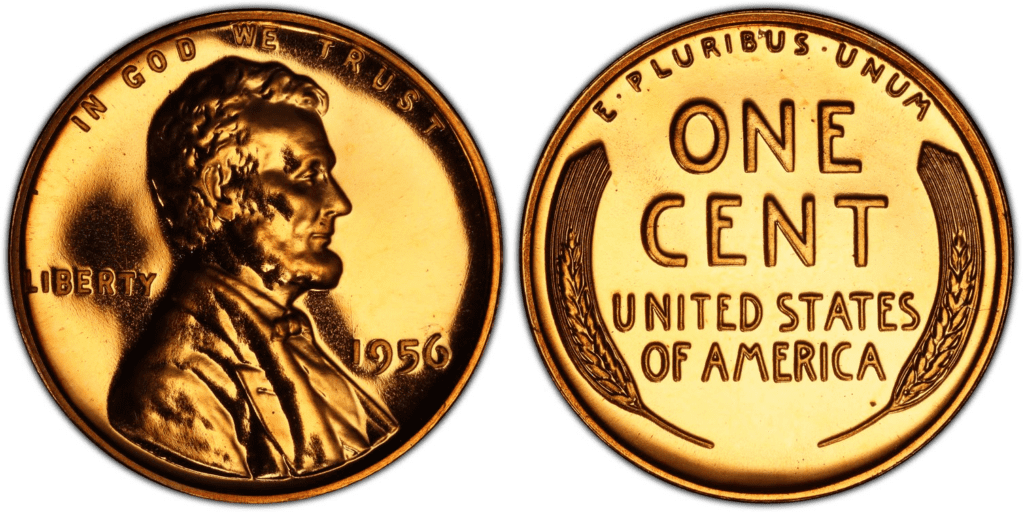
Aside from producing regular strike pennies, the Philadelphia Mint in 1956 produced proof coins, too. The proof coins are meant for collectors. Thus, you’ll notice that about 669,000 of this coin type were made in 1956. As a result, the price of the 1956-proof penny can easily reach $17.
List of 1956 Lincoln Penny Errors
With more than 1.5 billion of 1956 Lincoln penny, you will soon see how it can easily have error coins during the minting process.
Hundreds of 1956 Lincoln pennies received an RPM (repunched mintmark) error. This makes the coin have a D mark with a doubling appearance.
Another Lincoln penny error is the doubled die reverse (DDR) or doubled die obverse (DDO) error. This happened when the planchet was hit twice by the die. As a result, the engraved materials will look doubled, particularly on the letters.
However, not all DDR and DDO errors are prominent. Most of the time, you need a microscope or magnifying glass to find the error. However, the more pronounced the error is, the more valuable the coin is for collectors.
There are times when the error happens during the production and cutting of the planchet. Here’s an example of a coin with a planchet that seems to have a depressed area:
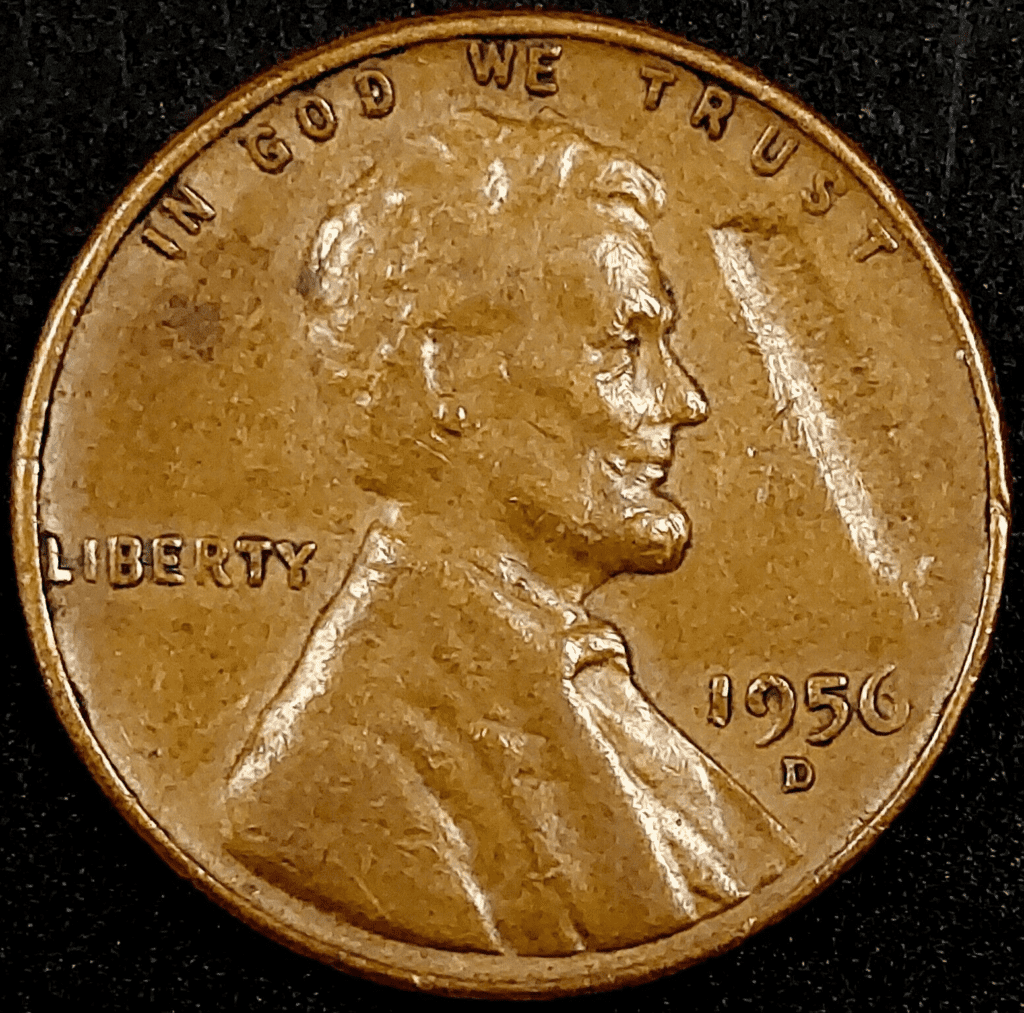
When the strike is too weak or the die fails, the resulting coin has an incomplete look. Here’s a coin that has a striking error:
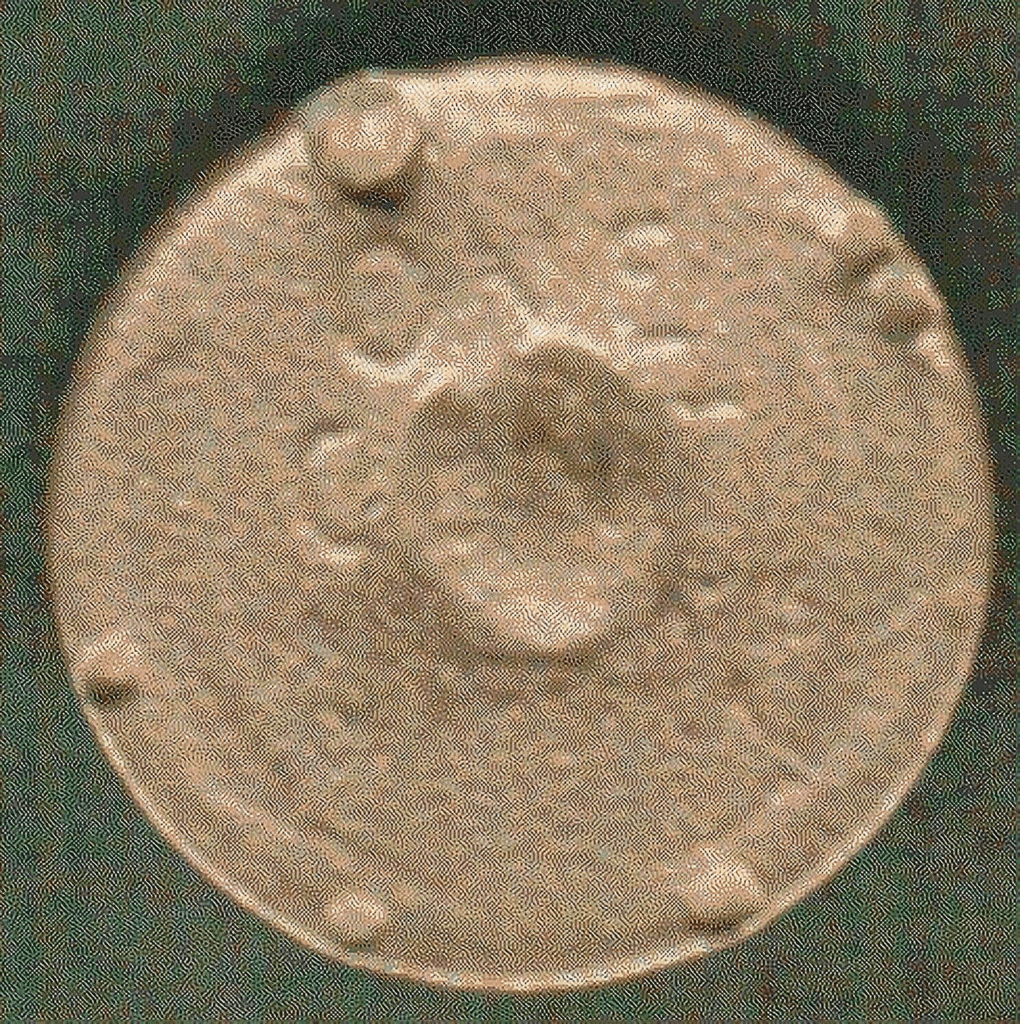
As you can see, error coins may not look good. They even look weird sometimes, but many coin enthusiasts would gladly want to have them in their collection. After all, error coins look fascinating and unique. In addition, some of the more expensive pennies are error coins.
How Much Is the 1956 Lincoln Wheat Penny Worth Today?
A penny is only worth 1 cent. So when you use a 1956 Lincoln wheat penny, you will surely be able to buy something worth its face value. Even if you look at the melt value of the 1956 penny, it isn’t that much. The melt value is $0.0253.
Nevertheless, you would be surprised to know that the wheat penny is not that worthless. On the contrary, 1956 Lincoln pennies are astronomically more valuable than their face and melt value.
Here’s a 1956 Lincoln Wheat Penny values chart to help you get an overview of its prices:
| Coin | Condition | Grade | Mintage | Value |
| 1956 D Lincoln penny | Circulated/mint | Not graded | 1,098,201,100 | $0.01 to $7.00 |
| 1956 D Lincoln penny | Uncirculated/mint | MS-64 | 1,098,201,100 | $15 to $33 |
| 1956 D Lincoln penny | Uncirculated/mint | MS-65 | 1,098,201,100 | $9 to $15 |
| 1956 D Lincoln penny | Uncirculated/mint | MS-66 | 1,098,201,100 | $7 to $17 |
| 1956 P Lincoln penny | Circulated/mint | Not graded | 420,745,000 | $0.01 to $7.00
|
| 1956 P Lincoln penny | Uncirculated/mint | MS-64 | 420,745,000 | $10 to $36 |
| 1956 P Lincoln penny | Uncirculated/mint | MS-65 | 420,745,000 | $17 to $80 |
| 1956 P Lincoln penny | Uncirculated/mint | MS-66 | 420,745,000 | $31 to $111 |
| 1956 Proof Lincoln penny | Circulated/proof | Not graded | 669,384 | $0.01 to $17.00 |
| 1956 Proof Lincoln penny | Uncirculated/proof | PR-67 | 669,384 | $15 to $55 |
| 1956 Proof Lincoln penny | Uncirculated/proof | PR-68 | 669,384 | $36 to $130 |
| 1956 Proof Lincoln penny | Uncirculated/proof | PR-69 | 669,384 | $121 to $159 |
As you can see, some 1956 wheat pennies are worth hundreds of dollars. Nevertheless, some pennies are still more valuable. For example, a 1956 proof penny with a grade of PR 68 was sold for $16,000 by Heritage Auctions in January 2003. Another 1956 P with a grade of MS67 Red Gem condition was sold for $13,200. For the 1956 D, the auction record is $7,475.
How Does The Grading System Work?
The Sheldon Scale is used by numismatists to provide a numerical value to coins. The Sheldon Scale goes from poor (P-1) to perfect mint state (P-1) (MS-70). Coins were originally evaluated using words to reflect their condition (Good, Fair, Excellent, Etc.). Unfortunately, coin collectors and dealers had different ideas about what each of these terms represent.
Professional numismatists joined together in the 1970s and established CoinGrading standards. These numismatists now assign grades at key places on the seventy-point scale, using the most regularly utilized numeric points in conjunction with the original adjective grade. The following are the most common coin grades:
-
-
- (P-1) Poor – Indistinguishable and probably damaged; if used, must have a date and mintmark; otherwise, rather battered.
- (FR-2) Fair – Nearly smooth, but without the damage that a coin graded Poor often possesses. The coin must have enough detail to be identified.
- (G-4) Fair – Inscriptions have merged into the rims in some areas, and important elements have been mostly erased.
- (VG-8) Very Good- A little weathered, but all of the primary design elements are visible, albeit faintly. There is little if any, central detail left.
- (F-12) Good – The item is very worn, yet the wear is even, and the overall design details stand out clearly. Rims are almost completely isolated from the field.
- (VF-20) Very Fine – Moderately weathered, with some finer features still visible. The motto or all letters of LIBERTY are readable. Both sides of the coin have entire rims that are separated from the field.
- (EF-40) Extremely Fine – Gently used; all gadgets are visible, and the most important ones are bold. The finer details are bold and clear, however, light wear may be seen.
- (AU-50) Uncirculated – Slight evidence of wear on the coin’s design’s high points; may have contact marks; eye appeal should be adequate.
- (AU-58) Uncirculated Choice – Slight traces of wear, no severe contact marks, almost full mint shine, and great eye appeal.
- (MS-60) Mint State Basal – Strictly uncirculated; no indication of wear on the coin’s highest points, but an unsightly coin with reduced luster, visible contact marks, hairlines, and other flaws.
- (MS-63) Mint State Acceptable – Uncirculated, but with contact scratches and nicks, little reduced shine, but otherwise appealing appearance. The strike is weak to average.
- (MS-65) Mint State Choice – Uncirculated with great mint shine, very little contact blemishes, and exceptional eye appeal. The strike is unusually severe.
- (MS-68) Mint State Premium Quality – Uncirculated with superb luster, no obvious contact marks to the naked eye, and exceptional eye appeal. The strike is quick and appealing.
- (MS-69) Almost Perfect Mint State – Uncirculated with perfect brilliance, a sharp and appealing strike, and extremely good eye appeal. A near-perfect coin with minor imperfections in the planchet, strike, and contact markings (seen only under 8x magnification).
- (MS-70) Mint State Perfect – Under 8x magnification, there are no tiny imperfections discernible; the strike is crisp, and the coin is perfectly centered on a beautiful planchet. Rarely seen on a coin, this coin is bright and whole, with original luster and exceptional eye appeal.
-
Where To Buy Or Sell 1956 Lincoln Wheat Penny?
The easiest way to buy or sell Lincoln wheat pennies would be through the Internet. There are a lot of websites today that would help you do this. Here are some examples:
- eBay
- Amazon
- Etsy
- USA Coin Book
- Coin Trackers
- JM Bullion
- And others
Aside from the Internet, you can go ahead and try getting in touch with local stores or companies. Here are some ideas for you to start with:
- Coin shops
- Pawnshops
- Antique stores
Some of the best US coins were sold through an auction. So, you may want to give auction houses a try. If you can, join clubs and groups of coin collectors. The more people you know, the more information you might get to see where you can buy and sell 1956 wheat Lincoln pennies.
FAQs
Is there a 1956 steel planchet-colored wheat penny?
The zinc-plated steel wheat penny was issued in 1943. 1956 pennies are made of copper, tin, and zinc. However, one seller on Etsy claims to have a 1956 steel planchet-colored penny.
Should I clean my wheat penny?
You can clean your wheat penny with the right solution to avoid damaging it. However, if you are trying to clean a rare 1956 penny, you might not want to do that, as doing so would devalue the coin. The best thing is for you to get in touch with professional numismatists and discuss your needs or concerns.
What wheat back penny is worth $1000000?
A 1943-S Lincoln wheat cent was sold for $1,000,000 in September 2012. Bob Simpson, co-chairman of the Texas Rangers baseball club, bought it. What’s unique about the 1943-S Lincoln wheat cent is that it was struck on a bronze planchet when it should be a steel planchet.
